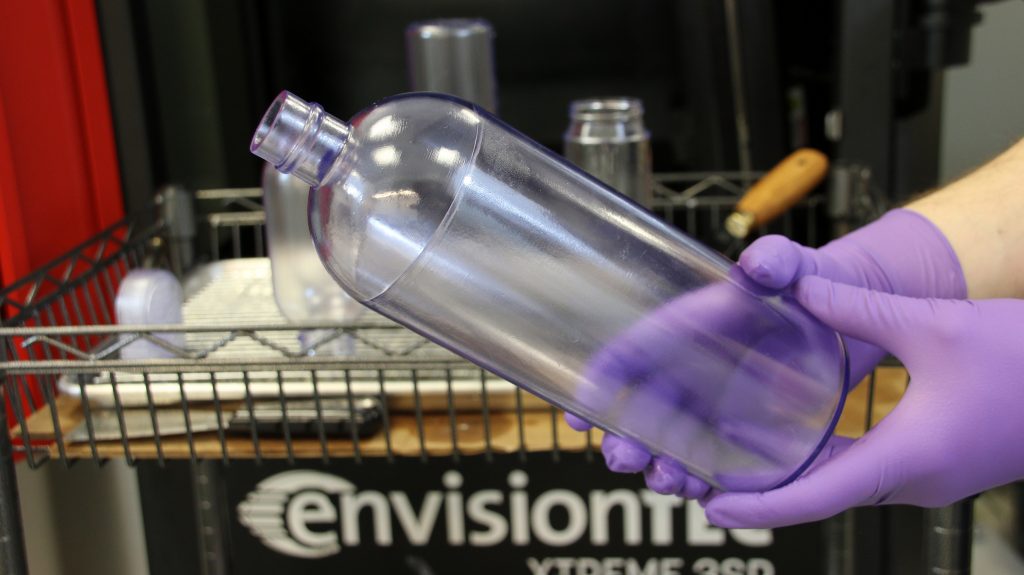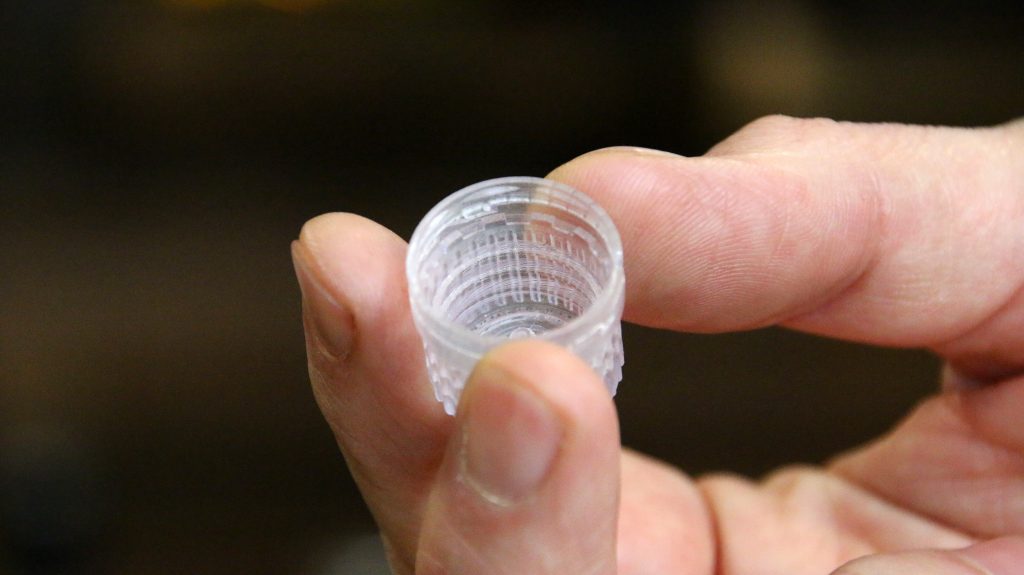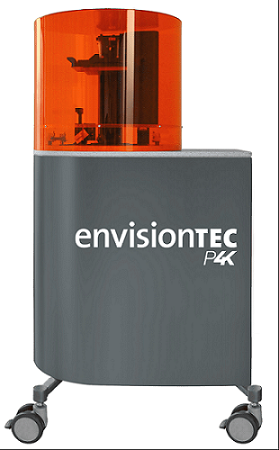We’re starting things off with a little business in today’s 3D Printing News Briefs, then moving on to news from the medical and construction industries, and finishing up with a few fun stories to make you smile. First up, Jeff Immelt, the former CEO of General Electric, has joined the board at Desktop Metal, and an industrial 3D printer distributor is offering a new cleaning unit by Omegasonics to its customers. Moving on, Insight Medical and Onkos Surgical are exploring the use of augmented reality in musculoskeletal oncology together, while Australian researchers introduced a new model for large-scale 3D facial recognition and a family has officially moved into the Nantes 3D printed house. Finally, a vegan confection startup is selling its popsicles, made with 3D printed molds, at select Starbucks locations in Los Angeles, and an EnvisionTEC 3D printer is being used to create characters for a stop motion series about superheroes.
Desktop Metal Board Welcomes Jeff Immelt

Jeffrey Immelt
Leading metal 3D printing company Desktop Metal, located near Boston, was founded three years ago with the goal of making metal 3D printing an essential tool for engineers and manufacturers. The company announced today that it has elected a new member to its Board of Directors – Jeffrey Immelt, the Chairman and CEO of GE until he retired from the company last year after 16 years. Immelt, who began his tenure only days before 9/11 and skillfully led GE through the crisis, has decades of experience, and is regarded as one of the most accomplished, innovative business technology leaders in the world. This makes him a valuable asset as Desktop Metal continues to grow.
“I am excited and honored to join the Desktop Metal board and work with this exceptional team of visionary entrepreneurs. Since it was founded nearly three years ago, Desktop Metal has become a trailblazer across the additive manufacturing landscape and I have a tremendous respect for the company’s ability to innovate,” said Immelt. “I look forward to sharing my experiences and contributing to the future direction and growth of this emerging metal 3D printing pioneer.”
Dr. Ken Washington, CTO and Vice President of Research and Advanced Engineering at the Ford Motor Company, was also recently appointed to the Desktop Metal board.
Industrial 3D Printer Distributor Offering Customers New Omegasonics Cleaning Unit

815BTX
Plural Additive Manufacturing, which is the exclusive North American distributor for industrial 3D printers by 3ntr, is offering the new 815BTX cleaning unit from ultrasonic cleaning systems leader Omegasonics to customers who purchase its 3D printers. The versatile and cost-effective unit is the 3D printing market’s first dual tank/dual action bench top ultrasonic cleaning machine, and can help easily remove water soluble support material.
The left tank of the 815BTX uses a biodegradable cleaning detergent developed by Plural, called BioSolv, while the right tank uses hot water; the model’s dual action then ensures the safe and efficient cleaning of 3D printed parts. The 815BTX also has programmable alternating cycles for hands-off cleaning.
“3ntr manufacturers’ of 3D printers utilize a variety of support materials, some require chemicals for support removal, while others need only hot water. The 815BTX eliminates the need to have two separate cleaning machines or deal with the cost of frequent cleaning detergent changes to get the job done,” explained Frank Pedeflous, the President of Omegasonics. “It’s an all-in-one solution.”
Onkos Surgical and Insight Medical Exploring Augmented Reality in Musculoskeletal Oncology
 California medical device company Insight Medical Systems has partnered with Onkos Surgical, Inc. on a pilot project to explore different applications and opportunities for using Insight Medical’s ARVIS (Augmented Reality Visualization and Information System) headset in musculoskeletal oncology, and possibly tumor surgery. Still under development, ARVIS uses its tracking and visualization capabilities to deliver efficient and precise surgical plan execution. The headset can project virtual models of a specific patient’s anatomy and implants into a surgeon’s field of view during a procedure, in order to show hidden anatomical structures and important measurements.
California medical device company Insight Medical Systems has partnered with Onkos Surgical, Inc. on a pilot project to explore different applications and opportunities for using Insight Medical’s ARVIS (Augmented Reality Visualization and Information System) headset in musculoskeletal oncology, and possibly tumor surgery. Still under development, ARVIS uses its tracking and visualization capabilities to deliver efficient and precise surgical plan execution. The headset can project virtual models of a specific patient’s anatomy and implants into a surgeon’s field of view during a procedure, in order to show hidden anatomical structures and important measurements.
“Onkos Surgical is investing heavily in capabilities and technology to bring innovation to musculoskeletal oncology surgeons,” said Onkos CEO and Co-Founder Patrick Treacy. “Augmented reality technology has the potential of simplifying the complex and providing surgeons with input and feedback that may improve the precision of surgical planning and interoperative workflow. This technology fits well with our portfolio of Precision Oncology solutions.”

University of Western Australia Introduces New Model for Large-Scale 3D Facial Recognition
 2D facial recognition is used often for applications in the IT, security, and surveillance industries, and relies on a computer model to know whether a person is legitimate or not. But this method has several issues, such as data being easily accessible online, which aren’t the case with more advanced 3D models. 3D models can address changes in facial expression, poses, scale, and texture, but the data can be hard to gather. Now, researchers from the Department of Computer Science and Software Engineering at the University of Western Australia (UWA) have developed a first of its kind system that can complete large-scale 3D facial recognition. The researchers, who published a paper on their work in Computer Vision and Pattern Recognition, analyzed 3.1 million 3D scans of over 100,000 people, and trained the innovative new 3D Facial Recognition model (FR3DNet) to learn the identities of a large dataset of ‘known’ persons, then match a test face to one.
2D facial recognition is used often for applications in the IT, security, and surveillance industries, and relies on a computer model to know whether a person is legitimate or not. But this method has several issues, such as data being easily accessible online, which aren’t the case with more advanced 3D models. 3D models can address changes in facial expression, poses, scale, and texture, but the data can be hard to gather. Now, researchers from the Department of Computer Science and Software Engineering at the University of Western Australia (UWA) have developed a first of its kind system that can complete large-scale 3D facial recognition. The researchers, who published a paper on their work in Computer Vision and Pattern Recognition, analyzed 3.1 million 3D scans of over 100,000 people, and trained the innovative new 3D Facial Recognition model (FR3DNet) to learn the identities of a large dataset of ‘known’ persons, then match a test face to one.
Dr. Syed Zulqarnain Gilani, who created the 3D model, said, “With off-the-shelf 3D cameras becoming cheap and affordable, the future for pure 3D face recognition does not seem far away.
“Our research shows that recognition performance on 3D scans is better and more robust. Your 3D scan could be in any pose, wearing glasses or a face mask, and laughing or just smiling and the deep model can recognise you in an instant.
“We hope that this research will help improve security on devices that use facial recognition to grant access to networks and systems.”
Nantes 3D Printed House Welcomes First Tenants
 In 2017, a collaborative team of researchers in France began an ambitious project where an industrial 3D printer and a patented concrete construction process called BatiPrint3D were used to build a five-room house in just days. This spring, after 54 hours of 3D printing and four months of contractors adding the roof, windows, and doors, the team finished the 95-square-meter, environmentally-friendly YHNOVA house in the district of Nantes Bottière. The house features wheelchair access and digital controls, and its curved walls are said to reduce the effects of humidity. But it still only cost around £176,000 to build – 20% cheaper than an identical house manufactured with traditional methods. Now, the NMH Housing Award Committee has allocated the house to a French family, and Nordine and Nouria Ramdani, along with their three children, are being hailed as the world’s first family to live in a 3D printed house.
In 2017, a collaborative team of researchers in France began an ambitious project where an industrial 3D printer and a patented concrete construction process called BatiPrint3D were used to build a five-room house in just days. This spring, after 54 hours of 3D printing and four months of contractors adding the roof, windows, and doors, the team finished the 95-square-meter, environmentally-friendly YHNOVA house in the district of Nantes Bottière. The house features wheelchair access and digital controls, and its curved walls are said to reduce the effects of humidity. But it still only cost around £176,000 to build – 20% cheaper than an identical house manufactured with traditional methods. Now, the NMH Housing Award Committee has allocated the house to a French family, and Nordine and Nouria Ramdani, along with their three children, are being hailed as the world’s first family to live in a 3D printed house.
Nordine said, “It’s a big honour to be a part of this project.
“We lived in a block of council flats from the 60s, so it’s a big change for us.
“It’s really something amazing to be able to live in a place where there is a garden, and to have a detached house.”
The THNOVA team now believes they can 3D print the same house in just 33 hours.
Dream Pops Selling 3D Printed Popsicles at LA Starbucks
 Vegan confection startup Dream Pops, headquartered in Los Angeles, creates organic, gluten- and soy-free, and vegan popsicles that are tasty, healthy, and made using 3D printed molds. These premier dairy-free popsicles consist of fruit and superfoods pureed together and cooled inside the molds at an accelerated rate with liquid nitrogen. Now, the startup has announced that its sweet treats are now available at five select Starbucks locations in the city – Third Street Promenade, La Brea and 4th, San Vincente and Barrington, Melrose and Stanley, and Wilshire and Santa Monica. The vegan ice cream pops, each of which contain fewer than 100 calories and seven grams of sugar, comes in five distinct flavors: Berry Dreams, Coconut Latte, Mango Rosemary, Vanilla Matcha, and a Dream Flight, which includes all four flavors.
Vegan confection startup Dream Pops, headquartered in Los Angeles, creates organic, gluten- and soy-free, and vegan popsicles that are tasty, healthy, and made using 3D printed molds. These premier dairy-free popsicles consist of fruit and superfoods pureed together and cooled inside the molds at an accelerated rate with liquid nitrogen. Now, the startup has announced that its sweet treats are now available at five select Starbucks locations in the city – Third Street Promenade, La Brea and 4th, San Vincente and Barrington, Melrose and Stanley, and Wilshire and Santa Monica. The vegan ice cream pops, each of which contain fewer than 100 calories and seven grams of sugar, comes in five distinct flavors: Berry Dreams, Coconut Latte, Mango Rosemary, Vanilla Matcha, and a Dream Flight, which includes all four flavors.
“Our aim is to become the Willy Wonka of plant-based confections starting with our first product the Dream Pop and extending into adjacent better-for-you desserts,” said Dream Pops Co-Founder and CEO David Greenfield.
Dream Pops’ popsicles will be available at these Starbucks locations until October 5th.
3D Printed Stop Motion Characters
 3D printing has been used many times to help create characters and backdrops for ads and commercials, music videos, and even movies that use popular stop motion animation. If you’re a fan of the stop motion show Robot Chicken, then you might also recognize the name of the full-service production company that creates it. California-based Stoopid Buddy Stoodios specializes in developing and producing stop-motion, CG, and 2D animated content, and also creates an animated stop motion comedy series called SuperMansion. The studio fabricates most of the show’s characters with a Perfactory 3D printer from EnvisionTEC.
3D printing has been used many times to help create characters and backdrops for ads and commercials, music videos, and even movies that use popular stop motion animation. If you’re a fan of the stop motion show Robot Chicken, then you might also recognize the name of the full-service production company that creates it. California-based Stoopid Buddy Stoodios specializes in developing and producing stop-motion, CG, and 2D animated content, and also creates an animated stop motion comedy series called SuperMansion. The studio fabricates most of the show’s characters with a Perfactory 3D printer from EnvisionTEC.
“By utilizing 3D printing, we’re able to tell a story about superheroes and love and conflict and action and adventure,” said Kei Chong, Digital Design Supervisor at Stoopid Buddy Stoodios.
To learn more, check out the video below.
3D Printing for Animation | Stoopid Buddy Stoodios from EnvisionTEC on Vimeo.
Discuss these stories and other 3D printing topics at 3DPrintBoard.com or share your thoughts below.

















